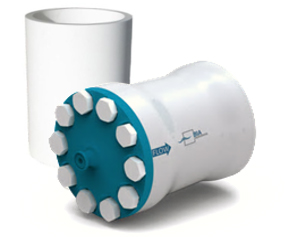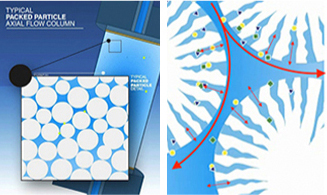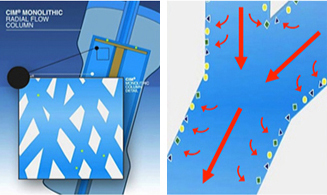CIM Monolithic Column
Inquiry of this product
Advanced Biochromatography Media
What's CIM Monolith?
Make Difference in Downstream Process by CIM Monolith.
Recent advancements in “expression system” technology have contributed to more efficient methods of bioprocessing. From cell modifications with signal sequences or affinity tags, myriad molecular variants for screening sources, and mass production using overexpression by gene amplification, overall process efficiency has improved. This progress has driven tangible results in both R&D and manufacturing settings resulting in continuous process improvement.
In contrast to recent innovations in “upstream” bioprocessing, the progress of purification methods and chromatographic media in “downstream” bioprocessing has been unable to meet consumer needs. How would you compare currently available chromatographic media with those available during the start of your scientific career? The industry is in need of a truly revolutionary idea which can challenge current bioprocessing norms and provide more than just an incremental advancement.
We, the manufacturer of Shodex; brand polymer based chromatography products is proud to announce the CIM monolith, a new solution for “downstream” bioprocessing. The CIM monolith is a truly next generation technology, designed with the current bio-engineer in mind. With the CIM monolith you can eliminate long run times and solve process instability issues caused by traditional packing material.

The Difference to Conventional Media
Convective Interaction Media(CIM)Technology ~Mechanism & Benefits~
- Conventional Media
The chromatographic separation is based on a difference in strength of interaction between the surface of stationary phase and subjected molecules. In conventional particle media, this interaction mainly occurs inside the mesopore (the nanometer-sized small pore) constructed on the surface of the resin. Although the exchange of mobile phase deep inside the mesopore is quite slow, the mass transfer inside the mesopore mainly depends on "natural diffusion".
As the molecular weight of the target increases, its natural diffusion rate in the mobile phase decreases. Larger molecules, including actively researched biomolecules, require more time to interact fully with the active sites on the stationary phase. This limitation is very apparent in particle based media. It is the primary reason running flow rate must be strictly limited to attain ideal resolution and high dynamic binding capacity (DBC) levels in chromatographic separation of large molecules.

- CIM Media
In Convective Interaction Media, mesopores, the underlying factor behind rate limitation in biochromatography, were eliminated from its structure. All chemical interaction points of the CIM are now practically placed on the surface of the flowpath. The target molecules which are transferred into the flowpath can immediately interact with the media surface without the limitation of their natural diffusion rate.
Also, with the elimination of mesopores or “flow path dead-ends”, backpressure is significantly reduced even under high flowrate. Due to fast and easily accessible interaction points of the CIM, bed height and thus overall process time are reduced. The high strength monolithic molding resin is free from distortion or compression by gravity or backpressure and can support the non-diffusive mechanism under varying practical conditions.
The "CIM monolith”, specially designed for biomacromolecules, achieved an amazingly rapid process time, low backpressure, high resolution, and high DBC value under high flowrate conditions. Using the CIM monolith, you no longer have to sacrifice results to achieve high process efficiency.

Inquiry of this product
